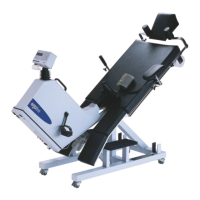Operation Manual
Version: 12/01
75
er900L Operation Manual
Art-Nr: 475.043
Ergometer
Type er900L
Appendix D: Indicators
age- A weight height
group n (years) (kg) (cm) PWC
130
PWC
150
PWC
170
20 -30 14 24,7 77,6 182 1,45 1,98 2,51
± 0,38 ± 0,38 ± 0,48
30 - 40 39 35,2 80,6 179 1,52 2,05 2,53
± 0,40 ± 0,41 ± 0,45
40 - 50 28 45,0 79,8 176 1,51 1,96 2,48
± 0,34 ± 0,37 ± 0,42
50 - 60 21 54,1 75,8 172 1,56 2,05 2,64
± 0,25 ± 0,30 ± 0,40
60 - 70 21 65,2 76,3 172 1,49 1,94 2,37
± 0,33 ± 0,33 ± 0,38
Standard values for PWC in watt/kg body weight. The mean deviation is ±0.4 watt
men women
PWC130 1,50 1,25
PWC150 2,00 1,60
PWC170 2,50 2,00
D.1 PWC Values
D.1.1 What is a PWC Value?
The PWC (Physical Work Capacity) value is an index of the physical power of a patient at a
given heart rate. Empirically derived values for men and women in various age groups are
used as objectives. Various authors have established PWC tables. Naturally there are mi-
nor performance variations in these assorted tables. To arrive at a standard, PWC values for
the following heart rates were calculated:
HR = 130/min. HR = 150/min. HR = 170/min.
These values establish what performance a patient in the assorted age groups should have
at a heart rate of 130, 150 or 170 beats per minute to be considered normal for his/her
respective patient group.
If only heart rate is considered with regard to a particular performance, the resulting absolute
value is of little significance (e.g. 200 watt at HR=150/min.). The patient’s weight must re-
ceive consideration with regard to the performance factor in order for the results to be rel-
evant and comparative. Continuing the same example, a patient with a weight of 100kg:
Performance at HR 150/min. = 200 watt
the resulting PWC value is:
PWC150 = 200 watt/100kg
= 2 watt/kg body weight
The following tables from the book „Stress Analysis in Practice“ from Rost and Hollmann can
be used as a standard for performance characteristics.
Table 5.3, Pulse relevant performance characteristics PWC130 PWC150 and PWC170, recorded in our institute, that are based upon non-condi-
tioned men between ages 30 and 70 given in, watt/kg.

